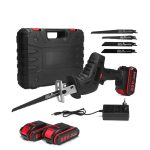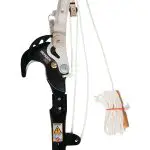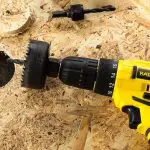As your woodworking skills improve, you need to expand your workstation. Careful planning may allow you to make the most space and optimize your productivity. Your task will become faster as well your workplace will be more pleasant. Thus, you can protect your instruments from scratching whatever the place is! Your new woodworking shop will suit your demands if you keep some essential points in your plan. Here, we will enlighten you on how to set up a woodworking shop in detail.
Go through the steps-
How to set up a woodworking shop? – Step By Step Process:
Step 1: Preparing the Space:
Before knowing- the woodworking workshop designs, you should select the area first. It is a fantastic idea to have a lot of space for your woodworking shop.
Many shop operations deal with long woods. A straight area may be preferable over a square space. Take into account the storage capacity, grinding, sawing, and installing power of your shop. Set your workspace such that your difficulties will be solved smoothly.
Step 2: Floor:
Typically, the floor that comes with your room is adequate. You can see concrete floors in several woodworking shops. Although the concrete floor may look beautiful, it may discolor after several uses. Also, it collects dirt which makes it harder to maintain.
The use of epoxy is a fantastic option. It can produce a premium sheen and protects against spills for a long time. It will also add more grip to your floor, and a polished texture will emit light. You can place padded floor carpets on workbenches or cabinets.
Step 3: Proper Lighting:
You can buy hanging lights for your shop at an affordable price. Try to use LED lights instead of fluorescent ones. They will not blink like fluorescents and have no impact by extreme cold or heat.
Though LEDs lights are expensive, they will save you money in the long term. Additionally, these lights consume less energy than other types of lighting.
Step 4: Temperature And Ventilation System:
You must maintain proper temperature and airflow in your woodworking shop, regardless of its size. It will keep the wellness of the environment of your workplace.
If your shop is attached to your home, ensure sufficient wall insulation of your house. Besides, you need to control the fluctuating temperature if your shop and home get separated.
We recommend you take a portable heater and extra clothes in the winter season. A fan or transportable air conditioning device could be a solution for the summer season. It aids in the reduction of moisture and the prevention of scorching. It is especially vital when working with wood.
Step 5: Organize Your Tools:
Do you know the importance of organizing tools? It is a pleasurable activity to create an arranged workplace. Rather than shopping for new machinery items, you can invest your days in manufacturing things. Store the unused parts of your woodworking shop in a toolbox. If you can not fit entire parts in your space, consider pre-cut resources.
Shopkeepers will trim them to fit your space. If you make a large piece of furniture, you’ll need to consider whether you can fix it.
Step 6: Place the Clamps closer to the Workbench:
Whether you want to assemble something on a workbench, put your clamps close by. However, you can apply a movable clamp cart too.
Step 7: Set your table Near a Window:
As most chemicals emit foul odors, it is logical to situate them near a window to get proper ventilation. An additional advantage is a direct sunlight, which aids with color matching.
Step 8: Make a Durable workbench:
It’s critical to have a sturdy workbench as you need to spend most of the time working on your tasks here.
Step 9: Shop-Vacuum:
A shop vacuum will allow you to maintain your workspace neat and dust-free. It is the next step for people on a budget.
Step 10: Bandsaw Wheel:
The bandsaw wheel generates fine dust, which tracks the speed of the blade. A further dust outlet at the tip of the lower wheel will become necessary to collect mud.
Step 11: Power Considerations:
If you are setting up a conventional woodworking shop, you’ll need a lot of power to run it well.
Never install extension cords all over your shop because they’re unsafe. So, place adequate outlets in all the prime locations of your shop.
110-volt and 220-volt outlets are perfect for any woodworking shop.
Use a 110-volt outlet with low horsepower motors. On the other hand, stationary equipment employs 220-volt outlets.
If you intend to use a 220-volt power source, your gadget should have its own plugin system. You need to add the types of outlets you’ll require.
Furthermore, widely obtainable outlets are critical for a small-spaced woodworking shop. It makes it simple to reach the socket to hook into it.
Step 12: Buy the Necessary Tools:
- Scroll Saw:
A scroll saw can be your best option for cutting the curves of the wood. It usually takes some effort. You can utilize this saw to make accurate and delicate cuts.
- Table Saw:
You can make flawless strokes with a table saw. Install a small table saw if you have a space problem.
Before selecting one, check its tear rate. The barrier mechanism should be robust as well.
- Track Saws:
A track saw delivers more precise cuts though it’s pricier than a circular saw. Drive the saw against a guide. Thus, you will get fine corners.
- Miter Saw:
You can make straight and angled crosscuts using it. A circular saw may accomplish the same task whenever a miter saw is hard.
It is a fantastic tool for getting started on basic jobs.
Expert Tips:
- If you have a small woodworking shop, try to avoid dark-colored walls. This technique will make your areas seem smaller.
- Chaotic spaces create a confined environment. Hence, maintaining your space will give you a welcoming charm.
- Thoroughly follow the directions, and go cautiously.
- Don’t be frightened of equipment.
- If you apply the tools appropriately, they can considerably improve the quality of your project.
- Maintain entire focus on the work.
- Have a clean shop. A dirty store soon develops a risky environment.
- After the operation, disconnect your tools.
- Most elevated applications generate sawdust. Safety glasses can mitigate these threats.
- Always have a fire extinguisher in your woodworking shop.
Summary:
When you begin complicated tasks, you will be seeking to expand your woodworking shop. We hope you found this article informative and get all your queries concerning how to set up a woodworking shop.
If there is anything left, contact us. We will be pleased to assist you. You don’t need to address everything on the steps we mentioned above. Try to select steps you want to focus on according to your budget.


















